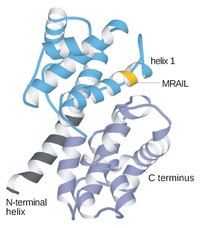
Photo from wikipedia
E-type cyclins, collectively called cyclin E, represent key components of the core cell cycle machinery. In mammalian cells, two E-type cyclins, E1 and E2, activate cyclin-dependent kinase 2 (CDK2) and… Click to show full abstract
E-type cyclins, collectively called cyclin E, represent key components of the core cell cycle machinery. In mammalian cells, two E-type cyclins, E1 and E2, activate cyclin-dependent kinase 2 (CDK2) and drive cell cycle progression by phosphorylating several cellular proteins. Abnormally elevated activity of cyclin E-CDK2 has been documented in many human tumor types. Moreover, cyclin E overexpression mediates resistance of tumor cells to various therapeutic agents. Recent work has revealed that the role of cyclin E extends well beyond cell proliferation and tumorigenesis, and it may regulate a diverse array of physiological and pathological processes. In this review, we discuss these various cyclin E functions and the potential for therapeutic targeting of cyclin E and cyclin E-CDK2 kinase.
Journal Title: Trends in cell biology
Year Published: 2021
Link to full text (if available)
Share on Social Media: Sign Up to like & get
recommendations!